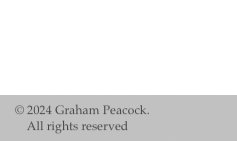|
The Art of Crazing
Abstract artist Graham Peacock explores the limits of acrylics
Terry Johnson. Alberta Report. December 7, 1987: page 59
By the early 1980s Edmonton abstract painter Graham Peacock had exhausted both of abstraction's twin themes, moving from his brightly-coloured but highly-segmented work of the 1970s, to his more muted but unified "all-over" abstracts at the turn of the decade. "Although they had my shape, they were still derivative," confesses the England-born University of Alberta art professor. Then, in 1982, came his personal artistic eureka. While exploring the natural puddling tendency of poured acrylic paint, he discovered "almost by accident" that he could exploit the cracking or "crazing" that occurs when paint is poured wet on wet. The result was a series of increasingly bold, thickly textured, and highly original canvases. Last week the Edmonton Art Gallery (EAG) opened the first retrospective showing of the pioneering artist's post-1982 work.
The exhibition will almost certainly revive nagging complaints that departing EAG director Terry Fenton has stressed abstract art at the expense of more realism University of Alberta professor and artist Peacock Large, irregularly framed, wildly-drawn canvases that leave many viewers bewildered. tic, easier-to-view work. "Like any art that is grandly conceived, [Mr.] Peacock's paintings are challenging," writes Russell Bingham in the EAG's own newsletter. The work, he suggests, is "physically assertive, almost bullying." Many of the exhibition's early viewers, left bewildered at the feet of the large, irregularly-framed and wildly-drawn canvases, would likely agree.
Still, the work's bright colours and originality have drawn critical praise. The 42-year-old Peacock, says Kenworth Moffet, a New York-based art critic and former curator of the Boston Museum of Fine Arts, "is one of the best-informed and most ambitious of the abstract painters under 50."
The uniqueness of Mr. Peacock's work is evident in his studio, only three blocks from the downtown EAG. It's dominated by the large wooden troughs in which his paintings are created. Writes critic Moffet: "Until now painters have always tried to avoid cracking, but [Mr.] Peacock works to induce and cultivate it. This involves working on the floor, using huge amounts of paint accelerating the drying process with large fans, and mixing the colour with cracking in mind. The resultant `drawing' is electric, aggressive and has an intensity of detail that is altogether new to abstract painting." The key is acrylic paint's tendency to dry from the outside in, first forming a skin that slows the evaporation of moisture from within. Applying another coat of paint over the first weakens the skin, causing it to fissure, pull apart, and reveal the wet paint underneath. The artist directs the process, but the procedure does its own drawing, explains Mr. Moffet. The result: a canvas of ridged, wrinkled paint, as much as eight inches thick, which is then cut and re-arranged into a final framed work.
Born in London in 1945, Mr. Pea?cock studied both painting and sculpture before earning a post-graduate fine arts degree from the University of Leeds. He came to the U of A as a lecturer in 1968, giving up a similar post at Eng?land's Newport College because in North America, unbridled by Europe's class structure and "taste for tradition," abstract art had "developed more substance." Edmonton, he says, proved to be "a very positive environment for artistic growth. There was a lot of energy and new ideas here. Through my teaching position, which allowed me to travel, I had access to the best work that was being done in North America." And in Edmonton low costs for studio space and materials, he says, "allowed for a lot of experimentation." Settling into his adopted home, he married a local lawyer and the couple now have three young children.
The 1982 discovery of the possibilities of crazing followed inevitably. "It was my breakthrough year," Mr. Peacock enthuses, his round fingers speckled with white paint. "In all the time I'd been painting I had been waiting for that day. Now I have something pf my own to do, and that's what every artist is looking for. Now that I've found it, the major work of my career has begun.
|
|
|



